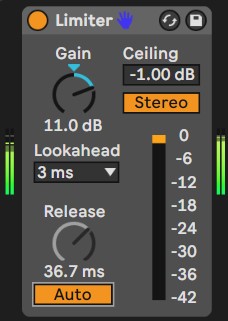Limiter
A limiter is very similar to a compressor but with a fixed ratio of 1:∞. You’ll find the Ableton limiter in the browser under Audio Effects > Dynamics > Limiter.

A limiter is typically used on the Master track to prevent clipping. Instead of a threshold, a limiter has a Ceiling. No signal will cross this ceiling, and that’s why it’s often referred to as a brick-wall limiter.
The limiter should always be the last device in the chain as other audio effects can add gain. I recommend keeping the ceiling on -1.00dB as this provides headroom when converting to MP3 files or other lossy file formats. This is also recommended by Spotify, YouTube, and other streaming platforms.
Ableton’s limiter has a Gain control for boosting or attenuating the signal level.
There’s also a look-ahead option with three settings: 1.5ms, 3ms, and 6ms. Look-ahead allows the compressor to look to the upcoming audio signal, therefore longer look-ahead times result in less distortion as it gives the limiter more time to respond.
This limiter has an automatic release time function that works perfectly in most situations, but you can turn this off to dial in your own release time between 0.01ms and 3 seconds. Shorter release times result in more distortion.
Finally, there’s also an option to change the response from Stereo to L/R. In stereo mode, the limiter reduces the gain equally on both channels, even when a peak only occurs on one side. In L/R mode, the gain is reduced independently, peaks in the left channel won’t affect the right channel. Useful to achieve more limiting, but it will affect the stereo field, so be careful with this option.
Limiting in general is a welcome tool to protect from occasional peaks. But never over-limit anything as it will suck all the life out of your tracks, ruining your dynamics and causing distortion. The yellow gain reduction meter is very helpful to visualize how hard the limiter is working. Adjust the gain so it only responds on occasional peaks and you’ll be fine.

